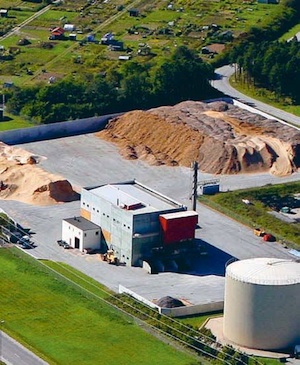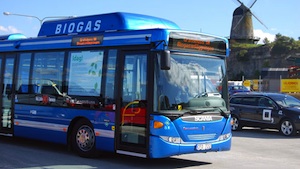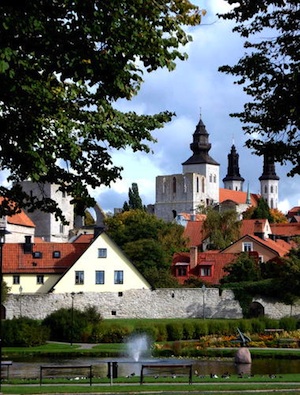Bio-fuelled district heating
A former Viking site on the island of Gotland, Visby was the main centre of the Hanseatic League in the Baltic from the 12th to the 14th century. Its 13th-century ramparts and more than 200 warehouses and wealthy merchants’ dwellings from the same period make it the best-preserved fortified commercial city in northern Europe.
Como um elemento na preservação dos edifícios de Visby, construção de uma rede de aquecimento urbano começou alguns 30 anos atrás. Agora, todo o calor no sistema de aquecimento de Visby é produzido usando um mix de energias renováveis.
Visby’s district heating project is not an isolated case on an island where the use of renewable is guaranteed. Gotland is a showcase for a number of interesting and innovative renewable energy initiatives. This is not really surprising. Gotland has Sweden’s highest sunshine figures, enjoys good access to biofuels and is one of the best European locations for wind power. These natural assets, the entrepreneurship of the islanders and the municipality’s focus on strategic environmental planning have led to the realisation of many ideas for increasing the sustainability of Gotland’s local energy supply.
Biocombustíveis no aquecimento de Visby
The World Heritage City of Visby consists of many unique buildings and mediaeval ruins that are built from limestone. Alguns dos seus edifícios mais antigos também têm portais e frisos lindamente esculpidas em arenito Gotland. Ambas as pedras são sensíveis a contaminantes do ar e, em especial, emissões provenientes da queima de combustíveis fósseis.
Em Visby como um todo, contas de aquecimento urbano por mais de 80 por cento de todo o aquecimento fornecido a estabelecimentos comerciais e residências. Para o benefício dos moradores de Visby e do património da cidade, Este aquecimento contribui para uma sociedade sustentável.
Environmental benefits are evident, since fossil fuels have not been used in Visby’s district heating since 2006. Aquecimento urbano elimina a necessidade de transporte de combustível nas ruas estreitas do centro da cidade de Visby. Além disso, the use of biofuels reduces the emission of sulphur and nitrogen oxides. Em comparação com a utilização de combustíveis fósseis, ela também reduz a adição de dióxido de carbono líquido para a atmosfera.
Desde 1980, emissões de enxofre provenientes de aquecimento de Visby caíram 95 por cento. Em comparação com o aquecimento individual, aquecimento, deixa o ar mais limpo e saudável para os moradores de Visby e do património cultural sensível da cidade.
A rede de aquecimento urbano em Visby leva o seu calor:
- Casca, galhos, ramos e outras (lascado) resíduos de desmatamentos e serrarias.
- Uma bomba de calor à base de água do mar com uma 11 MW de capacidade.
- Biogás do aterro encerrado em Visby.
- Biogás a partir da estação de tratamento de águas residuais.
- Bio-óleos que substituem os óleos fósseis.
In addition to that, the municipality has set very high standards for energy efficiency and they have launched a new plan for the historic centre, where energy aspects are integrated with a general plan for building conservation.
Eco-Municipality of Gotland
Visby is the seat of Gotland Municipality, which took the view to become “an ecologically sustainable society within the course of a generation”. Many years ago, the Municipality of Gotland adopted a route which would lead away from fossil fuels and towards reduced climate impact. Hoje, all electricity used in the municipality’s operations is certificated as Good Environmental Choice, which means that it is produced solely from renewable energy sources.
Gotland has implemented interesting reference projects in a wide range of experiences that include wind power, biogas, solar PV and sustainable architecture. The island has been a pioneer in promoting local ownership by wind co-operatives, where around 2000 households are involved.
Presentemente, one of the smartest electricity network in the world is currently under development on the island. This allows that by using modern technology, large quantities of renewable energy sources can be integrated in the grid.
Canada
Visby’s bio-fuelled district heating case shows the advantages of a smart alliance between renewable energy and heritage conservation, and can be taken as a model for many historic centres at those latitudes. This project is part of the common objective of achieving energy self-sufficiency from renewables by 2025, taking into account that the realisation of a Sustainable Energy System requires action at all levels of society.
The experience of Visby, and of Gotland in general, becomes more relevant if we take into account the geographical position of the island, in the middle of the Baltic Sea, that makes it a natural meeting place for cooperation between regions in the Baltic Sea Region.


















